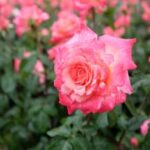Are you looking to create a beautiful and vibrant outdoor space? Look no further than the world of flower garden design layout. Whether you’re a novice or experienced gardener, designing a stunning flower garden can be a rewarding and fulfilling experience. From planning and selecting the right location to choosing the perfect flowers and implementing hardscaping elements, there are many factors to consider when creating an eye-catching flower garden design layout.
When it comes to flower garden design layout, planning is key. Understanding the basics of this process is vital in ensuring a successful and visually appealing outcome. From determining the best location for your garden to picking the right varieties of flowers, every step plays an essential role in achieving your desired result.
One of the first steps in creating a stunning flower garden design layout is choosing the right location. The ideal spot will receive ample sunlight, have good soil drainage, and complement the overall aesthetics of your outdoor space. Once you’ve found the perfect location, you can move on to selecting the perfect flowers for your garden. From vibrant annuals to low-maintenance perennials, there are countless options available to help bring your vision to life.
The Importance of Planning
The design and layout of a flower garden is an important aspect of creating a beautiful and harmonious outdoor space. Before you start digging or planting, it is essential to understand the basics of flower garden design layout to ensure the success of your project. Planning is crucial in achieving a well-designed flower garden that will thrive and bring joy for years to come.
One important aspect of planning for a flower garden design layout is determining the purpose of your garden. Are you looking to create a peaceful retreat, a vibrant display of color, or a functional space for entertaining?
The intended use of your flower garden will influence the overall design, plant selection, and maintenance required. It’s important to consider how much time and effort you are willing to invest in maintaining the garden so that you can choose the right plants and design elements accordingly.
Another key consideration in planning for a flower garden is assessing the environmental conditions of your chosen location. Factors such as sunlight exposure, soil quality, drainage, and climate must be taken into account when selecting plants and designing the layout. Understanding these basics will help ensure that your flower garden thrives in its specific environment. This also includes choosing native plants which are better suited for local climate conditions and require less maintenance overall.
Creating a budget for your flower garden design layout is also an essential part of the planning process. Whether you plan on hiring professionals or doing it yourself, having a clear budget will help guide decisions regarding plant selection, hardscaping elements, irrigation systems, and ongoing maintenance costs.
| Aspect | Consideration |
|---|---|
| Purpose | Determine how you want to use the space |
| Environmental Conditions | Assess sunlight exposure, soil quality, drainage, climate |
| Budget | Create clear budget guidelines for plants and maintenance costs |
Choosing the Right Location
When it comes to creating a beautiful flower garden, one of the most important factors to consider is choosing the right location. The location of your flower garden can significantly impact the growth and health of your plants, so it’s essential to determine the best spot before you start planting. Here are some key considerations for choosing the right location for your flower garden.
Sunlight and Shade
One of the primary factors to consider when choosing a location for your flower garden is sunlight. Most flowering plants require ample sunlight to thrive, so it’s essential to select a spot that receives at least 6-8 hours of direct sunlight per day. Take note of any trees or structures that may cast shade on the area throughout the day, as this can affect the amount of sunlight your plants will receive.
Soil Quality and Drainage
Another crucial aspect of selecting a location for your flower garden is assessing the soil quality and drainage. Different types of flowers have different soil requirements, so it’s essential to choose a spot with soil that is suitable for the types of flowers you plan to plant. Additionally, proper drainage is essential to prevent waterlogging, which can be detrimental to many flowering plants.
Proximity to Water Source
Consider how close your chosen location is to a water source. While you don’t want your garden in an area prone to flooding or sitting water after precipitation, having easy access to water for regular watering and maintenance is crucial for the health and vitality of your flowers.
By carefully considering these factors and conducting a thorough assessment of potential locations, you can ensure that you choose the best spot for your flower garden. Taking the time to select an optimal location will set the stage for a successful and thriving garden for years to come.
Selecting the Perfect Flowers
When it comes to designing a stunning flower garden layout, choosing the right flowers is essential. Here are some tips and advice for selecting the perfect flowers for your garden:
1. Consider the climate: Before choosing any flowers for your garden, it’s important to consider the climate of your area. Some flowers thrive in hot and sunny conditions, while others prefer cooler temperatures or shade. Research which flowers are best suited for your specific climate before making any decisions.
2. Determine your color scheme: Think about the overall color scheme you want for your flower garden. Do you prefer bright and vibrant colors, or are you more drawn to pastels and softer hues? Once you have a color scheme in mind, it will be easier to narrow down your flower choices.
3. Plan for different blooming seasons: To ensure that your flower garden looks beautiful throughout the year, choose a variety of flowers that bloom at different times. This way, you can enjoy colorful blooms from early spring to late fall.
4. Consider maintenance needs: Some flowers require more maintenance and care than others. If you’re a beginner gardener or simply want low-maintenance plants, opt for varieties that are easy to care for and don’t require constant attention.
By following these guidelines and doing thorough research on various flower varieties, you can create a diverse and visually stunning flower garden that will bring joy and beauty to your outdoor space.
Designing the Layout
When it comes to designing the layout of your flower garden, there are several important factors to consider in order to create a stunning and visually appealing space. One of the key elements to keep in mind is the overall structure and organization of the garden. This includes deciding on the shape and size of the flower beds, as well as considering any pathways or walkways that may be incorporated into the design.
Another crucial aspect of designing the layout is taking into account the various heights, colors, and textures of the flowers you plan to include. It’s important to create a sense of balance and harmony within the garden by arranging taller plants at the back and shorter ones towards the front. Additionally, mixing different colors and textures can add visual interest and depth to your garden design.
Incorporating focal points within your flower garden is also a great way to enhance its overall appeal. This could be achieved through the use of eye-catching features such as sculptures, birdbaths, or even a uniquely shaped tree or shrub. By strategically placing these elements throughout your garden, you can create areas of interest that draw attention and add personality to the space.
| Important Factors | Tips for Designing |
|---|---|
| Overall Structure | Decide on shape and size of beds; Consider pathways |
| Plant Arrangement | Create balance with height, color, and texture; Mix different elements for visual interest |
| Focal Points | Incorporate sculptures, birdbaths, unique trees or shrubs for added personality |
Implementing Hardscaping Elements
Designing a beautiful flower garden isn’t just about the flowers themselves – incorporating hardscaping elements can take your garden to the next level. Paths, borders, and features can add structure and visual interest to your flower garden design layout. Here are some tips and tricks for implementing hardscaping elements in your garden:
- Paths: Consider creating meandering paths throughout your garden to encourage exploration and create a sense of flow. Choose materials that complement the style of your garden, such as gravel for a more relaxed look or pavers for a more formal feel.
- Borders: Define the edges of your flower beds with borders, such as low walls, edging materials, or plantings. Borders not only help to keep your garden looking neat and organized but can also prevent soil erosion and provide a barrier against encroaching weeds.
- Features: Add visual interest and focal points to your garden with features like benches, trellises, statues, or water elements. These elements can create areas for rest and contemplation while adding personality to your space.
Incorporating hardscaping elements into your flower garden design layout requires careful consideration of how these features will complement the overall design. By thoughtfully integrating paths, borders, and features into your garden, you can create a cohesive and visually stunning outdoor space that enhances the natural beauty of your flowers.
Whether you choose traditional materials like stone or wood or opt for more unconventional options like recycled materials or artistic installations, hardscaping elements can elevate the aesthetic appeal of your flower garden design layout while also adding functionality and structure. Don’t be afraid to get creative – the possibilities are endless.
Maintenance and Care
Maintaining a beautiful flower garden design layout requires consistent care and attention to ensure that the flowers thrive and the overall aesthetic remains stunning. From regular watering to controlling pests and diseases, there are several important factors to consider when it comes to maintaining your garden.
Regular Watering
Proper watering is essential for the health and vitality of your flowers. It’s important to water your garden early in the morning or late in the afternoon to minimize evaporation. Be sure to water the base of the plants, as wet foliage can lead to disease. Consider installing a drip irrigation system for efficient and even watering.
Weeding and Mulching
Weeds can compete with your flowers for nutrients, sunlight, and water, so it’s crucial to regularly remove them from your garden. Applying a layer of mulch around your plants can help suppress weed growth and retain moisture in the soil. Additionally, mulch can enhance the visual appeal of your flower bed.
Pest Control and Disease Prevention
Inspect your garden regularly for signs of pests or diseases, such as wilting leaves, unusual spots, or holes in the foliage. If you notice any issues, take action promptly using organic pest control methods or fungicides. Proper air circulation and avoiding overhead watering can also help prevent common plant diseases.
By implementing these maintenance practices, you can ensure that your flower garden design layout remains healthy and beautiful throughout the season, allowing you to enjoy its beauty for years to come.
Inspiration Gallery
When it comes to creating a stunning flower garden design layout, sometimes it can be difficult to visualize exactly how you want your garden to look. That’s where an inspiration gallery comes in handy. By showcasing stunning examples of flower garden design layouts, you can gather ideas and inspiration for your own project.
In the inspiration gallery, you will find a wide variety of flower garden designs, each unique in its own way. From traditional English cottage gardens to modern minimalist designs, there is something for every taste and style. You’ll be able to see how different types of flowers are used, how hardscaping elements such as paths and borders are incorporated, and how the overall layout contributes to the beauty of the garden.
By browsing through the examples in the inspiration gallery, you can start to envision what you want your own flower garden design layout to look like. Maybe you’ll find a particular color scheme that appeals to you or a specific type of flowering plant that catches your eye. The gallery is meant to spark creativity and help you bring your vision to life in your own outdoor space.
Conclusion
In conclusion, creating a beautiful flower garden design layout is a rewarding and fulfilling endeavor. By understanding the basics of planning, choosing the right location, selecting the perfect flowers, and designing the layout with hardscaping elements, you can create a stunning garden that will bring joy and beauty to your outdoor space. Additionally, providing proper maintenance and care will ensure that your flower garden remains healthy and vibrant for years to come.
As you embark on the journey of designing your own flower garden layout, remember to take inspiration from the stunning examples showcased in our inspiration gallery. These examples can ignite your creativity and provide ideas for how you can personalize your own garden to reflect your unique style and preferences.
So embrace the beauty of nature by creating your own flower garden design layout. Whether it’s a small backyard garden or a sprawling landscape, the joy of witnessing the vibrant colors and fragrant blooms in your own space is truly unparalleled. With careful planning and thoughtful execution, you can create a captivating flower garden that will be a source of delight for yourself and others who have the pleasure of experiencing it.
Frequently Asked Questions
How Do I Layout My Flower Garden?
When laying out your flower garden, consider the size and shape of the space, as well as the amount of sunlight it receives. Start by mapping out the areas for planting, pathways, and any structural elements like trellises or statues.
Group plants according to their water and sunlight needs, and consider layering with taller plants in the back and shorter ones in the front. Ultimately, the layout should be both aesthetically pleasing and practical for maintenance.
How Do You Arrange Plants in a Flower Garden?
When arranging plants in a flower garden, think about their heights, colors, and blooming times to create visual interest throughout the seasons. Incorporate a variety of textures and shapes to add depth to the garden.
Consider incorporating focal points like a large flowering bush or a decorative urn to draw attention to certain areas. Also, don’t forget about edging plants or ground cover to define borders and fill in empty spaces.
What Is the Most Effective Garden Layout?
The most effective garden layout will depend on factors like climate, soil type, available space, and personal preferences. However, many gardeners find that a combination of symmetrical and asymmetrical layouts works well, creating balance while also adding interest.
Using curves instead of straight lines can make a garden feel more dynamic and natural. Additionally, incorporating different layers like trees or shrubs in the back, mid-sized perennials in the middle, and low-growing annuals at the front can create a visually appealing design with varying heights.

Welcome to my gardening blog! I am passionate about plants and enjoy sharing my knowledge and experiences with others. In this blog, I will write about everything related to gardening, from tips on how to get started to updates on my own garden projects.





